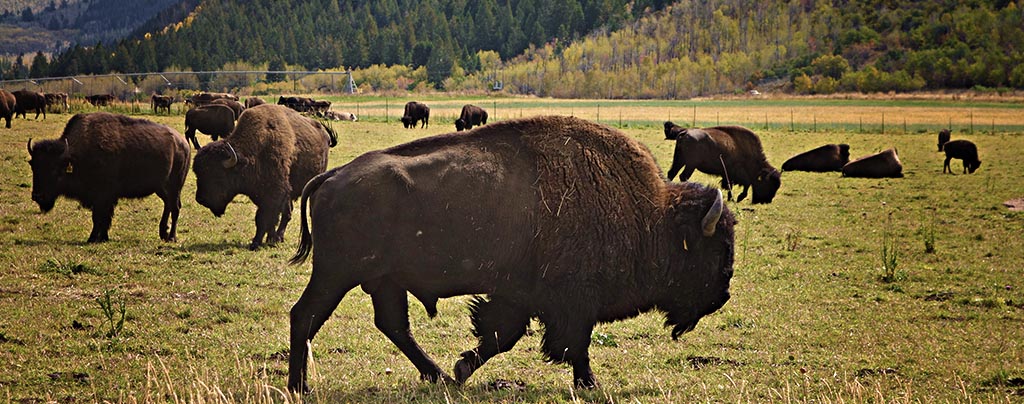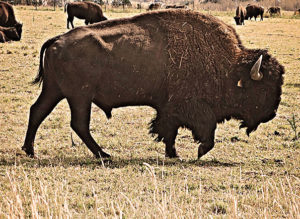Buffalo / Bison Facts

How much does a buffalo weigh?
There can be a large range, but the average mature bull weighs 2,000 pounds and the average cow 1,100 pounds. Buffalo calves normally weigh 40–50 pounds at birth.
How fast can buffalo run?
Buffalo can reach the alarming speed of up to 40 MPH.
What do buffalo eat?
Buffalo are native to North America and do well on native grasses and prairie hay. Their diet may be supplemented with range cake if necessary.
What is the life span of a buffalo?
The average buffalo lives 20–25 years.
How many buffalo are there in North America?
Despite the fact that buffalo nearly went extinct due to mass overhunting, today there are approximately 500,000 head.
How does buffalo meat differ from beef?
Individual types of cuts of buffalo are identical to beef, except for color. Raw buffalo meat is a deeper red than raw beef because buffalo meat does not have internal streaks of fat (also known as marbling). The lack of fat streaks is one thing that makes cooking buffalo meat different than cooking beef: fat is an insulator, so when it is present, the heat must penetrate the fat in order to cook the meat. There is also less moisture in the meat, so it is easy to overcook and dry the meat if you are not used to cooking buffalo meat.
Do ranchers cross-breed bison with cattle?
The National Bison Association is dedicated to maintaining the integrity of the species. In fact, our Code of Ethics specifically prohibits members from deliberately crossbreeding bison with another species. However, the issue of cattle genetics in bison is extremely sensitive and complicated. The bison in private and public herds today are descendants of the buffalo that were gathered by a few individuals who helped save the species from extinction at the end of the 19th century. Some of those individuals experimented briefly with crossbreeding bison and cattle. The resulting offspring did not display any “hybrid vigor,” so those individuals quickly abandoned the practice. Many bison today still carry small traces of cattle genetics from that period in history. While many ranchers today are testing their herds to selectively remove those traces, they are also careful not to eliminate important bison genetics that survived the “bottleneck” of near-extinction in the late 1800s.
What is the difference between bison and buffalo?
Scientifically, the term “buffalo” is incorrect for the North American species; its proper Latin name is Bison bison. However, common usage has made the term “buffalo” an acceptable synonym for the American bison.
Where did the word ||buffalo|| come from?
In the seventeenth century, French explorers in North America referred to the new species they encountered as “les boeufs,” meaning oxen or beeves. The English, arriving later, changed the pronunciation to “la buff”. The name grew distorted as “buffle,” “buffler,” “buffillo,” and, eventually, “buffalo.”
What is the approximate birth weight of a bison calf?
They normally weigh between 40 to 50 pounds. They are usually up and walking or running with their mothers within a couple hours of being born.
What is the gestation period for a female bison?
The gestation period for the American bison is 9 1/2 months. Under normal conditions, cows have their calves from mid-April through June. Cows generally have one calf per year, but twins may occur very rarely.
How many calves will a bison have in her lifetime?
Female bison breed when they are two years old and have their first calves when they are three. Cows can live to be 20-25 years old having a calf each year under the right conditions.
How long does it take a bison calf to become an adult?
Bison calves are normally weaned when they are around six months old. Females generally weigh around 350 lbs. at this time and males weigh around 425 lbs.
Are bison gentle or aggressive?
Bison are not domestic animals and should be treated with caution and respect. Each animal has its own distinct personality.
What Regulations Govern the Inspection of Bison sold into the Commercial Retail and Restaurant Marketplace?
Under the Federal Meat Inspection Act, bison are classified as an exotic, or “non-amenable species,” and thus operate under some unique regulatory provisions. All bison marketed into the commercial marketplace must be processed in an FDA-approved facility. These facilities are required to comply with all FDA regulations, as well as with the FSIS regulations regarding sanitation. Bison producers/processors may also request “voluntary inspection” services from the U.S. Department of Agriculture’s Food Safety and Inspections Service (FSIS) or from an accredited state-inspection program which offers inspection “at least equal” to the USDA’s. According to the USDA, 68,300 head of bison were processed under USDA inspection or in an accredited state-inspected facility in 2009. This accounts for 99 percent of the bison marketed for meat. Further, products processed under USDA inspection will carry a triangle seal of inspection, and all products processed under a qualified state inspection program will carry the official seal from that state inspection program.

